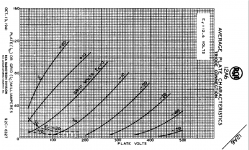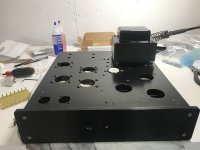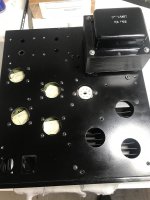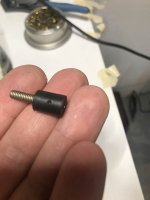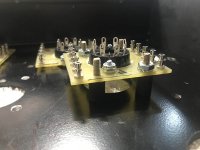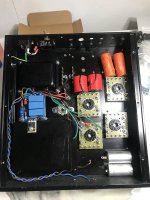RCA 12A6 data sheet has triode curves:
http://frank.mif.pg.gda.pl/sheets/049/1/12A6.pdf
http://frank.mif.pg.gda.pl/sheets/049/1/12A6.pdf
Attachments
Salas, I congratulate you both for the project and for the sharing and I wanted to ask you a couple of things (I have only read part of the many comments, so if I say things already forgive me)
1) Have you tried to make 6v6 work on a slightly more linear point? How for example bringing the V of the cathode to about 10v?
The V measured at the anode after the resistor should be around 180v and the current around 30ma
2) Have you tried to polarize the cathode with a series of LEDs instead of the resistor and capacitor?
thank you
1) Have you tried to make 6v6 work on a slightly more linear point? How for example bringing the V of the cathode to about 10v?
The V measured at the anode after the resistor should be around 180v and the current around 30ma
2) Have you tried to polarize the cathode with a series of LEDs instead of the resistor and capacitor?
thank you
I'm sure Salas will come in with an answer here. My own experience of using IXTP08N100D SIC diodes in the cathode has been that in the end I prefer a resistor. Tried the SIC diodes with numerous valves and in the end I abandoned them. They were quite expensive, so now I have 100 not in use and looking for another home! I first heard them in Ale Moglia's system and they sounded nice with a 01A, but I haven't been able to reproduce that.
I'm trying out 6V6 and several other medium pentodes in triode (EL84 etc) as drivers for my 300b output stage, using plate chokes and teflon FT-2 coupling caps. I'm trying to avoid the bypass cap with an operating point that gives me a resistor of under 200R. Easier with valves like EL84 with lower bias voltages.
I'm trying out 6V6 and several other medium pentodes in triode (EL84 etc) as drivers for my 300b output stage, using plate chokes and teflon FT-2 coupling caps. I'm trying to avoid the bypass cap with an operating point that gives me a resistor of under 200R. Easier with valves like EL84 with lower bias voltages.
Last edited:
Thanks Salas. I tried your version and I must say it sounds very good. For now it's just a prototype and I used two 10k ceramic resistors of 10w each connected in parallel as load: despite the sum being 20 w they heat a lot. I think I will soon compare it with my project made some time ago, an asymmetrical srpp consisting of a 6sn7 low valve and 2 6v6 high valves.
In the works!
I'm working on a version of Salas' preamp that has the gain version and also the CF version in one. There will be a switch to choose which mode, and also a way to run one into the other, so gain with a follower.
For the gain + CF I was thinking to use this sometimes as a headphone amp, ala Bottlehead Crack. To do this I need a 100 uF or so output cap. Would using a cap this large negatively affect the sound when used as a line preamp?
Any suggestions on decent 100uF caps for this purpose that are not massively large?
I'm reusing a chassis and transformer from another project, so have the room for 4 tubes. I'm also using a neurochrome 21st century maida.
Thanks!
I'm working on a version of Salas' preamp that has the gain version and also the CF version in one. There will be a switch to choose which mode, and also a way to run one into the other, so gain with a follower.
For the gain + CF I was thinking to use this sometimes as a headphone amp, ala Bottlehead Crack. To do this I need a 100 uF or so output cap. Would using a cap this large negatively affect the sound when used as a line preamp?
Any suggestions on decent 100uF caps for this purpose that are not massively large?
I'm reusing a chassis and transformer from another project, so have the room for 4 tubes. I'm also using a neurochrome 21st century maida.
Thanks!
Attachments
Oh ok, I thought it might be able to drive a pair of 300 ohm headphones.
The "Bottlehead crack" has a similar typography, advertises at 120 ohm output impedance, but measured closer to 180 here:
Bottlehead Crack Headphone Amplifier Kit Review | Audio Science Review (ASR) Forum
The CF has around 250 Rout right, so thinking it would be similar bit maybe not?
The "Bottlehead crack" has a similar typography, advertises at 120 ohm output impedance, but measured closer to 180 here:
Bottlehead Crack Headphone Amplifier Kit Review | Audio Science Review (ASR) Forum
The CF has around 250 Rout right, so thinking it would be similar bit maybe not?
Crack was found with 188Ω Zo in that test, expect 220Ω from this 6V6 preamp's buffer mode says my LTspice simulation, so yes they are near in this regard. But is this standard good enough? Technically inadequate for headphones use, it needs a transformer. Same thing mentioned in the Crack test as well. But you could still give it a listen with 300Ω headphones and decide. HiZo may alter their response to your subjective liking. Use some nice 220uF 450V electrolytic for output capacitor. 450V has better ESR. Can be bypassed with a small film too.
You could branch to an adequate value film capacitor for line out, tap just before the big electrolytic cap used for HP out. Use bleeder resistors to ground at the output of those caps. 470k & 47k should do. Some output delay system with relay and DC monitoring like those used in power amps may come handy. To engage after warm up avoiding slow cap charge near DC cycles and on/off pops on cans.
Also a muting / cut off line out scheme with a switch should prove handy for when you need to use headphones for a while without turning off the power amp.
You could branch to an adequate value film capacitor for line out, tap just before the big electrolytic cap used for HP out. Use bleeder resistors to ground at the output of those caps. 470k & 47k should do. Some output delay system with relay and DC monitoring like those used in power amps may come handy. To engage after warm up avoiding slow cap charge near DC cycles and on/off pops on cans.
Also a muting / cut off line out scheme with a switch should prove handy for when you need to use headphones for a while without turning off the power amp.
For a newby wanting to try this project as both the buffer and gain versions, what schematics would I start with? It seems to be a well regarded project. But forgive me It's such a long thread! is post #1 kept updated with the best schematic to start with?
I recently won 16 pristine NOS Hytron 6V6 military-grade carbonized glass tubes in a brutal run up auction on eBay. I'll be breadboarding and testing with a used Sylvania of course, but I want to plan a worthy project for these carbonized Hytron 6V6GT's.
I recently won 16 pristine NOS Hytron 6V6 military-grade carbonized glass tubes in a brutal run up auction on eBay. I'll be breadboarding and testing with a used Sylvania of course, but I want to plan a worthy project for these carbonized Hytron 6V6GT's.
Yes those schematics linked from post #1 are valid. You can differentiate on the PSU solution though.
You may use a 50k Log pot too. Are your Hytrons brown base?
No they are black base pre CBS Hytron but made in the 1941-43 timeframe and from the same production run and appear to be off the military quality production line but not JAN marked. I got 16 for $160, considering that pristine NOS 6V6GT seem to avg $12 I think I did good. In boxes with no insertion marks on the pins.
Making some progress. A quick question about grounding- I know this is an eternal topic and have read a lot generally, but I haven't found anything specifically on it in this thread:
I have a local star ground happening for the power supply section, and now I'll start to get into the input and output sections.
Should I use a loop breaker on this part? (i.e cap, 10R, diodes) as a signal ground? Or just use a local star ground for the input and output sections?
I have a local star ground happening for the power supply section, and now I'll start to get into the input and output sections.
Should I use a loop breaker on this part? (i.e cap, 10R, diodes) as a signal ground? Or just use a local star ground for the input and output sections?
I had measured with AC supply in the past and a regulated DC heaters supply with return to chassis ground will give you a quieter noise floor in this preamp, especially in the gain mode. The LM317 current source reg designed for this preamp back in the day performs well but it may need tweaking between different enough heater current tube samples. And it creates enough dissipation on each LM317. One of the reasons it was made dual mono.
With a newer generation low noise 1.5A spec LDO like the LT1963 you can make a classic 6.3V voltage source common between tubes reg with closer calculated Vin for less power dissipation.
With a newer generation low noise 1.5A spec LDO like the LT1963 you can make a classic 6.3V voltage source common between tubes reg with closer calculated Vin for less power dissipation.
- Home
- Amplifiers
- Tubes / Valves
- 6V6 line preamp
